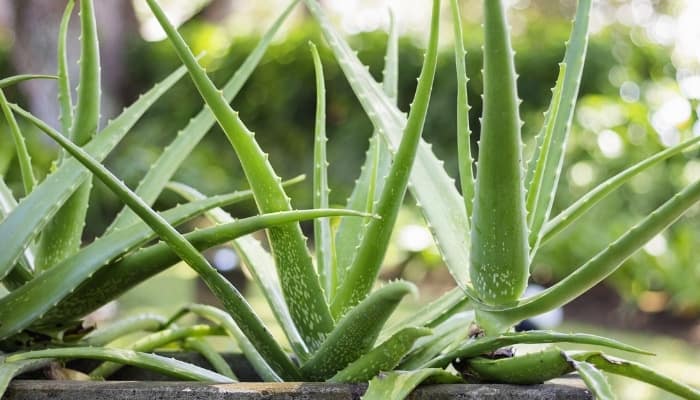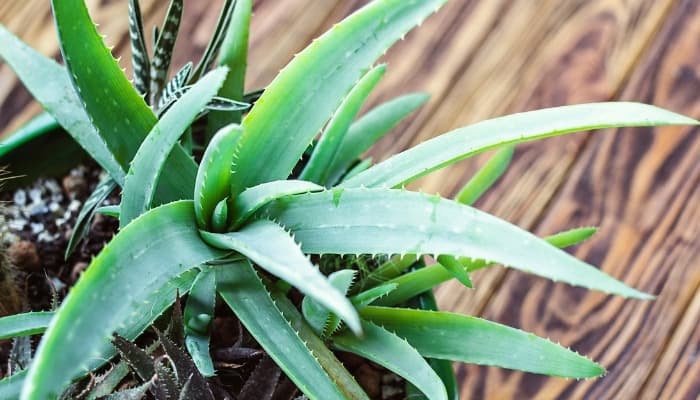Aloe vera is a type of indoor plant that can withstand not being watered or fed regularly without experiencing stress, wilting, or dying.
It’s the perfect houseplant if you have a busy schedule and don’t have much time to care for your plants.
As succulents, aloes are slow growers to the point where you would start to doubt if they are growing at all. The slow growth of the aloe vera includes both the crown and root system.
Does aloe like to be root bound? Even when aloe vera roots start to get a little overcrowded in the pot, there’s no urgency to repot the plant. It can get root bound and still grow at the same slow rate. However, eventually you’ll need to transfer it to a bigger pot with fresh soil.
There are times you’d have to repot your aloe vera, even when it is not root bound. Root rot is one such case.
Continue reading to find out when you should repot aloe vera and how to do it without shocking the plant in the process.
When To Repot Aloe
One of the most challenging aspects of caring for aloe is to keep track of the slightest changes that show that all is not well with the plant.
It has to do with its excruciatingly slow growth and the fact that the plant is hardy to drought and adverse growing conditions.
Unless you’re quite attentive, by the time you notice that the plant is struggling, it can be too late to save it. This applies to repotting as well.
Do Aloe Roots Like To Be Crowded?
The hardy aloe can do with a little amount of soil in small pots. When the roots get crowded, it will not complain or go into a self-preservation mode. In fact, aloes like to have crowded roots.
This gives you ample time to plan for and repot the plant at your leisure.
Aloe Vera Root Bound Symptoms
Sooner or later, the overcrowded roots will become severely root bound. With no soil in which to grow and absorb nutrients, the roots put pressure on the container, which could crack it.
The roots will also stray out of the drainage holes at the bottom of the pot in search of nutrients and moisture.
The crown itself will start to show signs of illness. The leaves of the succulent will turn yellow at the bottom. In severe cases, they would turn brown as the plant stops growing altogether.
Other Instances When Repotting Is Necessary
Even when you have a large container with plenty of space for the aloe, there are times when repotting is necessary. This often has to do with the soil itself.
If the plant has root rot, then you need to repot it and use fresh soil after trimming the damaged and rotted roots.
If the soil is old or worn out and no longer contains nutrients or has the ability to retain moisture, repotting will be necessary.
Also, if the plant has grown so large that the container easily tips over, it’s time for a new pot, even if the roots are not yet crowded.
How To Repot Aloe
When it’s time to repot your aloe vera, make sure you have everything you need in advance, including the new pot, growing medium, and all the tools you need.
Aloe vera is prone to transplant shock, and you shouldn’t leave the roots exposed to air more than necessary.
- Choose a pot that is 1-2 inches larger than the current one.
- Fill one-third of the pot with a potting soil for succulents (like this excellent mix).
- With gloves on, extract the aloe from the pot gently. If it’s in a plastic container, cut through the side and take out the root ball intact.
- Prune any damaged leaves.
- Examine the roots, and trim rotted, damaged, or entangled ones with sterilized scissors.
- Place the aloe in the middle of the pot, and spread the roots out to fill the bottom.
- Refill the pot with the potting mix, and stop just below the edge of the bottom leaves.
- Water the soil to help it settle.
Aloe Vera Growing Conditions

Even though aloe vera is a hardy plant, it still needs the right growing conditions to help it develop a robust crown.
Best Soil for Aloe Vera
Well-drained soil is the ideal choice for aloe vera. You can make your own potting mix by mixing perlite with sand and coco peat.
Aloe Vera Light Requirements
Some direct sunlight can be tolerated, but too much sun can burn and dry out the leaves.
To avoid this potential issue, place the plant in an area that receives bright indirect sunlight for 6-8 hours each day.
Aloe Vera Temperature Tolerance
On average, you should keep the room temperature between 60 and 75 degrees Fahrenheit. Aloes growing in the garden can tolerate temperatures between 50 and 85℉.
Aloe Vera Watering Schedule
Generally, you should water your aloe vera lightly once every 2 to 3 weeks during the growing season. In the fall and winter, cut down on this watering pattern to once every month.
If the top third of the soil feels damp when you go to water the plant, skip that watering, and check back in a few days.
Continuously moist soil can quickly lead to root rot, the number one killer of aloe plants.
Allow the soil to dry thoroughly between waterings, and always ensure that water is able to drain out of the pot quickly.
Best Fertilizer for Aloe Vera
Because of its slow growth rate, aloe doesn’t need much feeding.
A fertilizer high in phosphorus with an NPK of 10-40-10 will do the trick as will fertilizers designed especially for aloe and succulents.
Repotting Aloe Vera Pups
After cutting the pups, you’ll need to plant each one in its own pot.
Use the same potting mix as the mother plant, and make sure the pups are deeper in the soil than before you cut them. Water immediately.
Aloe Vera Transplant Shock
Aloes don’t like to have their roots exposed to the air for long. This can cause them to dry out and cause transplant shock.
Use great care when handling the plant, and make sure to water the plant immediately with lukewarm water after transplanting it.
Related Questions:
Are Aloe Vera Plants Toxic to Cats?
Aloe vera is mildly toxic to cats, so keep it away from your pets. Symptoms include vomiting, lethargy, tremors, and diarrhea. You should get medical help immediately if your cat ingests aloe.
Are Aloe Succulents?
Aloes are succulents, not cacti. They store water in their thick leaves, much like other succulents.
Conclusion
Aloe vera is a succulent with roots that can tolerate getting overcrowded.
When the succulent gets root bound, repot it after pruning old and damaged leaves, and then water it immediately to avoid transplant shock.

